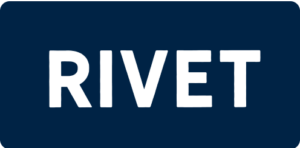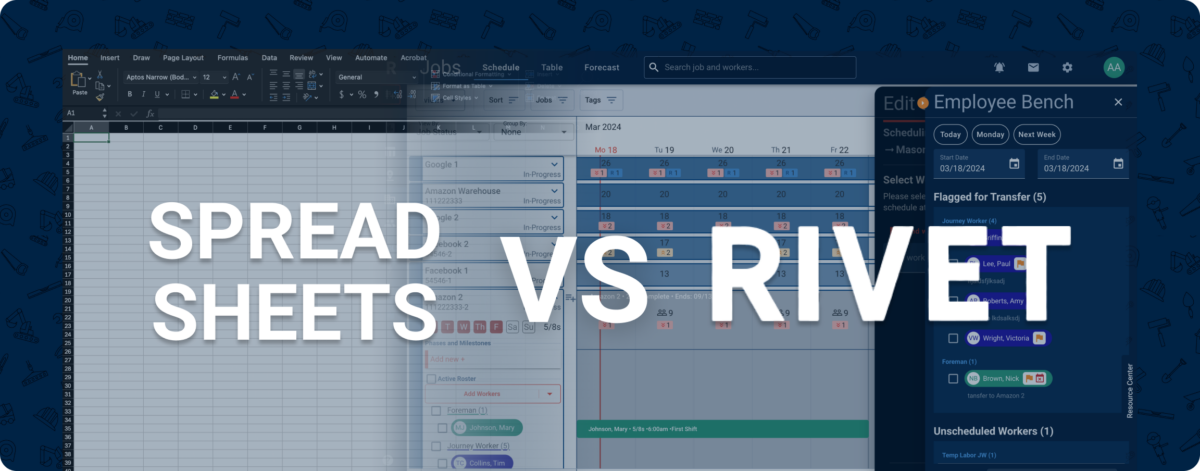Is it time to stop using spreadsheets for labor planning?
Once you get past a certain size, spreadsheets just can’t keep up with the demands of Labor planning and Workforce Management. No matter how good yours are, they’re going to fall short eventually.
Life has gotten easier for contractors who’ve ditched their spreadsheets for the RIVET Workforce Management platform. Business has gotten more profitable, too. Our customers report up to six percent gains to their margins. Consistently.
If that isn’t enough to sway you, read on for 17 more reasons why you should leave spreadsheets behind.
Spreadsheets are a great DIY solution when it comes to planning your workforce, but your solution can soon become a pain as others need to use it
Start today.
Adopting the RIVET Workforce Management Platform can have a huge impact on your field productivity and profitability.
1. Guided and Structured Interface
Overview: Apps offer a guided and structured interface, making it easier for users to navigate and understand the required tasks.
Pain: Solutions are only as effective as the user experience they provide. Spreadsheets come with a fixed interface, forcing users to adapt complex tasks like scheduling and dispatching into a rigid grid format. Additionally, spreadsheets lack the flexibility to show or hide features based on need, limiting their adaptability and usability.
Solution: With a platform like RIVET, you get an interface that was explicitly designed to solve a specific problem. The result is an intuitive experience with drag and drop elements, making it easier to get the job done.
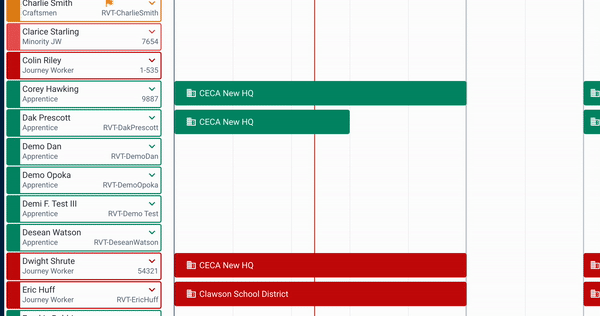
2. Role and Permission-based Access
Overview: App access can be gated, ensuring that users only see the information relevant to their duties. This Controlled Transparency enhances security within a construction project.
Pain: Anyone who can view a spreadsheet can see all its data, risking unauthorized access. Locking cells is tedious and error-prone. Spreadsheets may work for small teams, but as they grow, managing individual access becomes impractical.
Solution: Apps revolutionize management by allowing you to set specific permissions and create groups with defined roles. As your team grows, this functionality becomes crucial, enabling swift management and ensuring the right people have access to the right tasks, providing you with peace of mind.
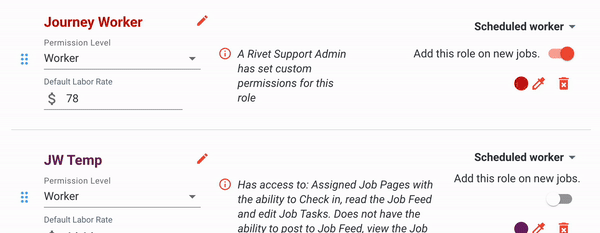
3. Real-time Information
Overview: Job site conditions and requirements change rapidly on construction projects. Real-time data exchange gives team members access to up-to-date Rosters, Schedules and job site changes.
Pain: Spreadsheets limit your ability to keep everyone up to date. Team members may work on different versions of the same spreadsheet, causing inconsistencies and confusion. Spreadsheets don’t update in real-time either, leading to outdated information and slow decision-making.
Solution: Information is a core pillar of Workforce Management, and without real-time updates, you risk falling behind. An app ensures everyone stays in sync with the project, facilitating seamless updates and communication.
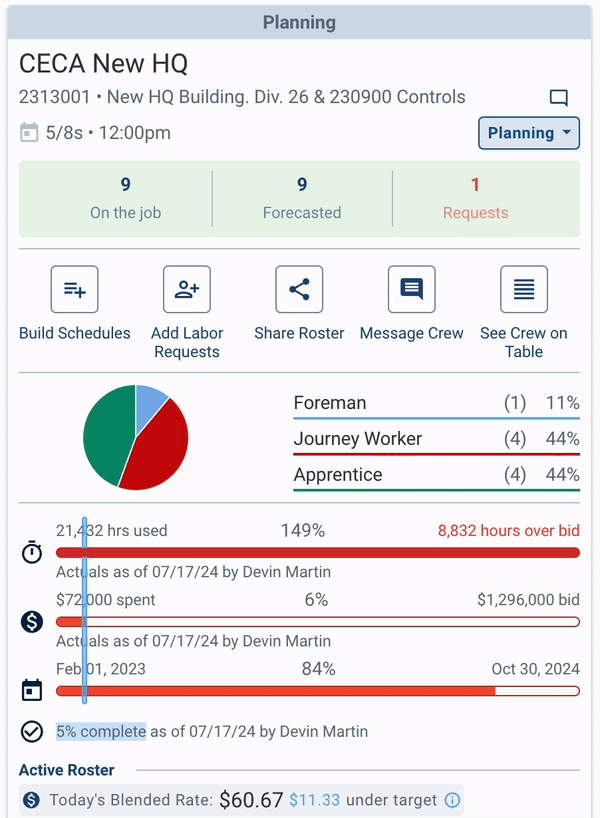
4. Efficient Notification System
Overview: Apps easily alert the right people about required actions and updates via Notifications. Notifications ensure that all team members are promptly informed, reducing delays and improving response times.
Pain: Project managers must manually send updates and Notifications, increasing the risk of missed communications. Delays in notifying team members about changes can lead to project delays and inefficiencies.
Solution: Apps can quickly Notify multiple people within seconds, ensuring timely updates. Additionally, team members can respond and update information in real-time, maintaining synchronization and efficiency (see reason #3).
“Using RIVET gives us the ability to move manpower in large quantities. If we need to move 50 to a job, it’s a couple clicks, whereas in the old days we’d be calling people. RIVET gives us the ability to automatically notify the project managers, the foreman, the superintendents as well as the field personnel.” —Dave Krausmen, VP/ Motor City Electric Technologies
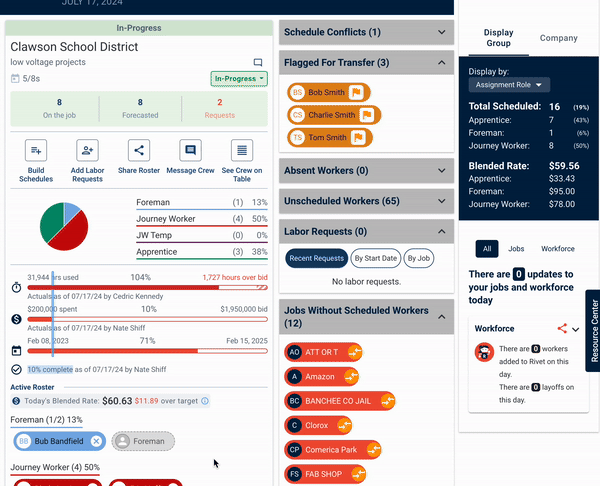
5. Purpose-built Charts and Graphs
Overview: With an app, project managers can access purpose-built graphs and charts pulled from existing data. Quickly see project metrics, Labor Curves and more without extensive manual setup.
Pain: Creating charts and graphs in spreadsheets demands a deep understanding of data and proper structuring, which is time-consuming and requires advanced skills. This makes it difficult to quickly generate meaningful visualizations and insights.
Solution: Apps offer interactive charts and graphs designed to interpret your data, updating in real-time to provide accurate and efficient analysis.
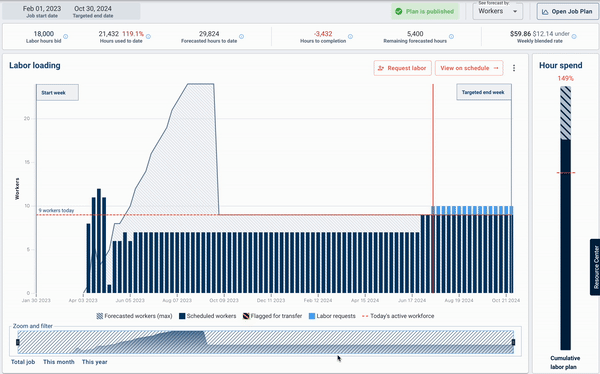
6. Built-in Automation
Overview: An app’s automations streamline repetitive tasks like reporting and Scheduling. This reduces administrative burden, empowering managers to focus on Workforce Management strategy.
Pain: Spreadsheets require manual handling of repetitive tasks like data entry and report generation, increasing workload. Not only does this take longer, but there’s a higher chance for errors due to manual processes. This impacts the data and report accuracy.
Solution:
If a human can do it twice, then a computer can do it twice as fast.
– Anthony Montalbano, RIVET Director of Operations
That’s the power of automation in applications. Automation is fast, consistent and gives you peace of mind to work more efficiently.
7. Scalability
Overview: Apps easily scale to accommodate a construction project or workforce’s growing needs, without significant investment in new infrastructure or software.
Pain: As data volume increases, spreadsheets can become cumbersome and slow, negatively impacting performance and usability. Scaling up often demands more manual management and investment in advanced spreadsheet software.
Solution: Cloud-based apps offer virtually limitless data and resources, making it easy to scale your Workforce Management needs effortlessly and efficiently.
“Our larger accounts have 100s of workers and jobs, all going at once. Previously every job would need its own Roster and Forecast spreadsheet and then they’d need to be collated into a master spreadsheet for org-level Labor Demand charts.
When an organization reaches that size, it tends to have multiple business units. Apps free up business unit managers to tune out the noise and just focus on their jobs and workers – not the entire company’s.” Louis Gelinas, RIVET Co-Founder and Director of Product.
8. Data Integrity and Backup
Overview: Web apps often offer robust data integrity and backup solutions. This ensures critical project and workforce information are stored securely and can be recovered in the event of local data loss.
Pain: Spreadsheets are more prone to data corruption and loss, especially if they aren’t regularly backed up. Managing multiple versions can lead to data discrepancies and loss of critical information.
Solution: Cloud-based apps are always on and backed up fairly often. For example, RIVET pairs comprehensive daily back ups with weekly integrity-tested backups.
“At RIVET, our integration platform is designed to seamlessly connect with industry-leading ERP and accounting systems such as Trimble Spectrum, Trimble Vista, Foundation, and Sage 300. We have numerous customers who complete their labor planning lifecycle by leveraging these integrations.” – Andy Lawrence, RIVET Co-Founder and CTO
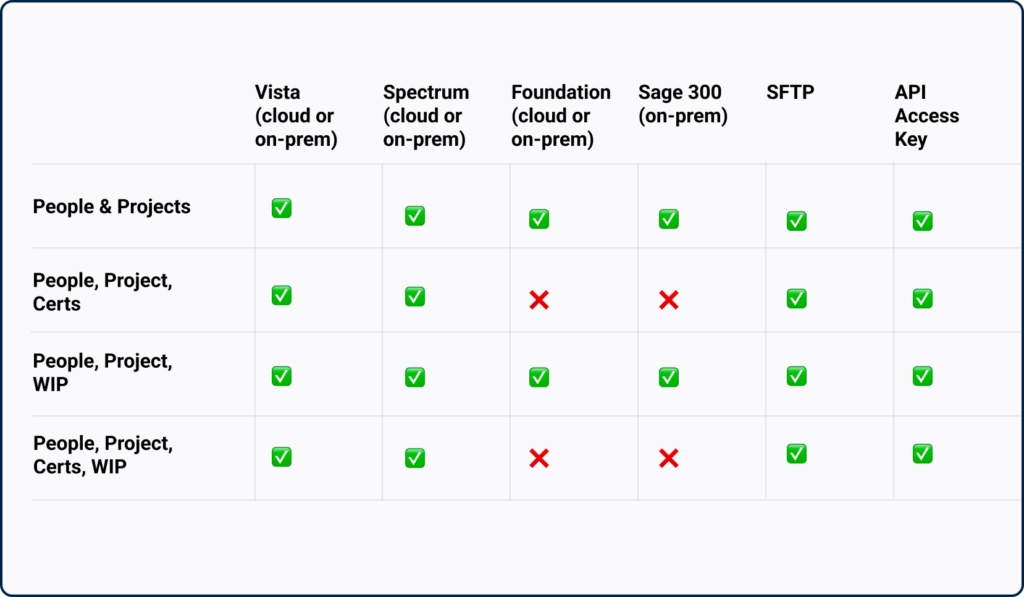
9. Cost-effectiveness
Overview: Web apps prove more cost-effective than spreadsheets, over time. They reduce the need for extensive manual data entry and lower the risk of errors, streamlining communication and task management.
Pain: You’ve heard it before, time is our most valuable asset. While spreadsheets can solve many problems, they do so at the expense of time and efficiency.
Solution: To determine the ROI of a WFM platform, compare its cost to a journeyman’s salary. If the annual subscription is $25,000, saving just a quarter of a journeyman’s cost justifies the expense. With a $10,000,000 labor budget, even a 1% efficiency gain with a WFM tool saves $100,000.
10. Enhanced Collaboration
Overview: Web apps provide a central platform for collaborating and sharing key business information like Rosters, Schedules and Labor Plans.
Pain: Spreadsheets are not designed for real-time collaboration, leading to difficulties in sharing and updating information simultaneously. Lack of a central platform for communication and document sharing hinders team coordination.
Solution: Cloud-based apps like RIVET empower multiple users to view and update information in real-time, ensuring everyone stays up-to-date regardless of their location. This level of universal, accessible collaboration isn’t possible with spreadsheets.
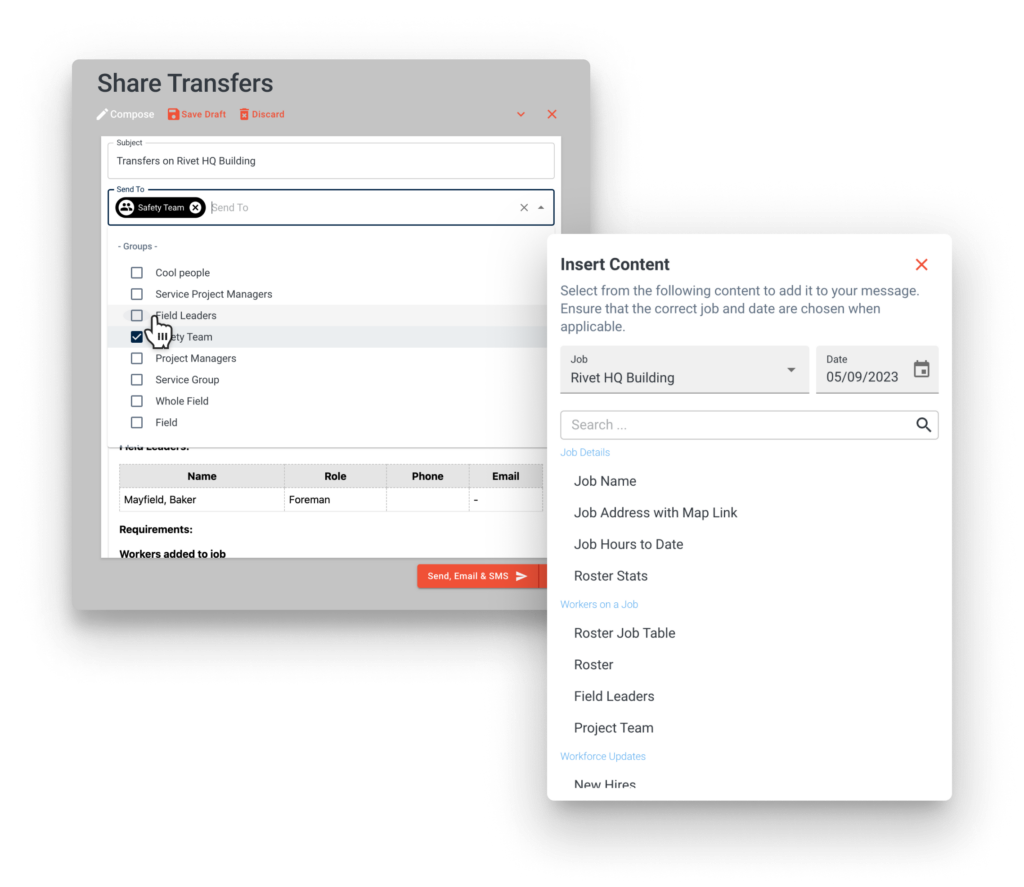
11. Customization and Flexibility
Overview: Apps are highly customizable, giving project managers the power to create custom workflows and reports tailored to their organization.
Pain: Customizing spreadsheets for specific project needs is challenging and often requires advanced skills. Spreadsheets lack the flexibility to adapt to changing project requirements efficiently.
Solution: Apps are designed to address specific needs while offering the flexibility to adapt to your team’s workflow. In contrast, spreadsheets lack the customization options and consistency required for effective workforce management.
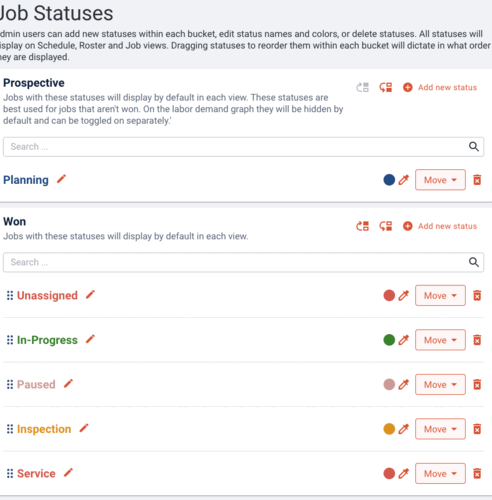
12. Integration Capabilities
Overview: Plenty of apps integrate with your existing tools like accounting and ERP systems. This seamless flow of information improves project management and decision-making.
Pain: Integrating spreadsheets with other tools (e.g., ERP software) is complex and often requires manual data transfer. Lack of integration leads to data silos, reducing overall efficiency and decision-making capabilities.
Solution: Apps partner with other popular software applications allowing your team to seamless work and share information between systems. For example, RIVET integrates with over 10 platforms including Vista, Viewpoint Spectrum, Sage 300 and Foundation.




13. Enhanced Reporting and Analytics
Overview: Apps with built-in analytics tools provide insightful reports and analytics on project performance, workforce productivity, budget adherence and more.
Pain: Spreadsheets offer basic analytics, requiring significant manual effort to generate advanced reports. Creating detailed and insightful reports takes considerable time and effort.
Solution: Applications create custom reporting and analytics tailored to your specific needs, presenting information in an easy-to-understand format. This allows you to focus on managing your projects rather than designing reports. Additionally, these applications update data in real-time, ensuring your reports are always current.
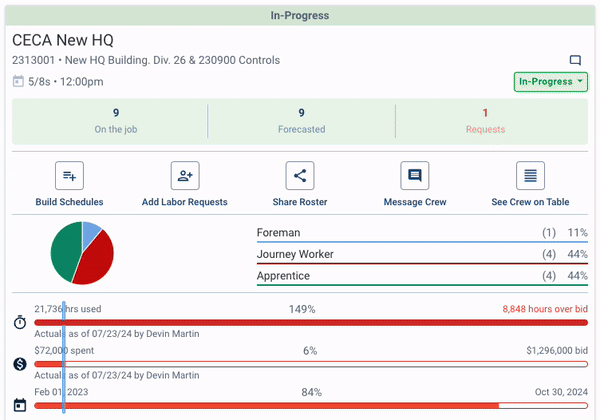
14. Mobile Access and Functionality
Overview: Plenty of web apps are designed to use on the go. Mobile-friendly designs and support for SMS means field workers and managers can access critical info from nearly anywhere.
Pain: Spreadsheets aren’t optimized for mobile devices, which makes it difficult for field workers to access and update information on the go. A lack of mobile-specific features reduces efficiency for on-site workers and managers.
Solution: Apps are not only optimized for mobile use but also have the capability to seamlessly send SMS messages to personnel in the field, ensuring effective communication and timely updates regardless of location.
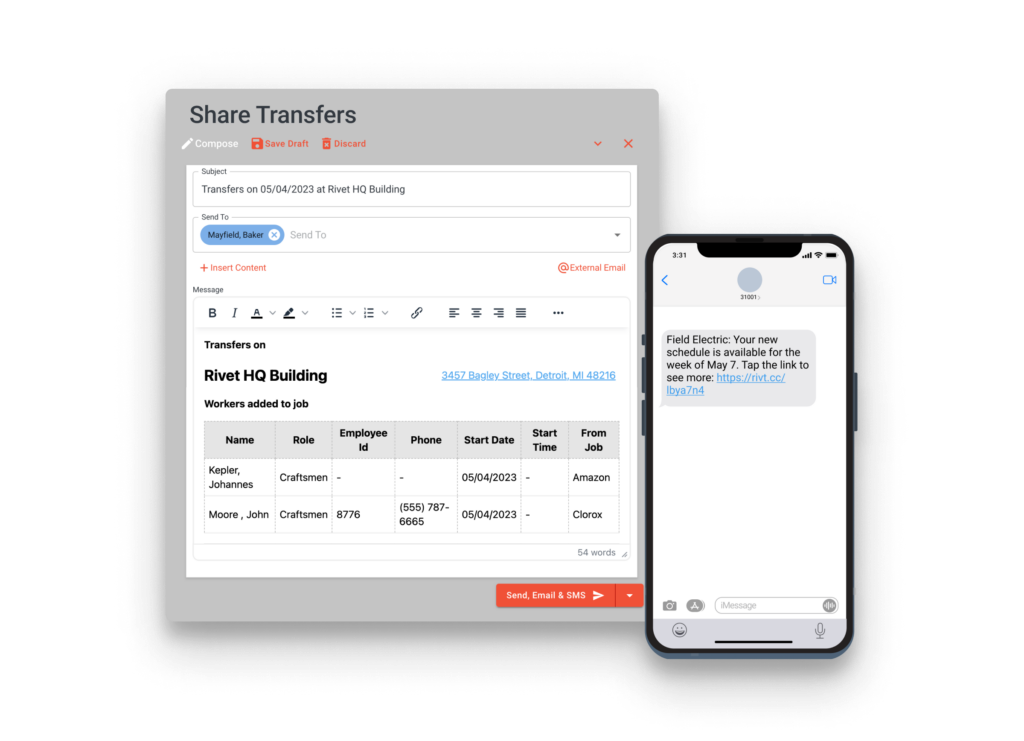
15. Training and Support
Overview: Apps offer comprehensive training and support, which helps teams quickly adopt a platform and use it to its full potential. This support is crucial to smooth implementations and lower learning curves.
Pain: Limited formal support and training for using spreadsheets can lead to a steep learning curve for new users. Teams may struggle to adopt and efficiently use spreadsheets without proper guidance.
Solution: Applications offer training and support tailored to your specific needs, with multiple options for assistance, including chat, email, and phone calls. Instead of trying to fit your problem into a generic tool, you receive expert training and support from professionals who already understand your unique challenges.

16. Cross-platform Compatibility
Overview: Web apps work across platforms, meaning anyone can access them from just about any device that connects to the internet — without the need for platform-specific software versions.
Pain: Spreadsheets may not perform consistently across different devices and operating systems. Ensuring all team members have access to compatible software versions can be challenging.
Solution: Applications provide a consistent experience across multiple platforms and are designed to address the right problems based on popular use cases for each platform. For instance, mobile apps can handle SMS messaging efficiently, while desktop versions offer user-friendly interfaces for managing tasks like scheduling labor.
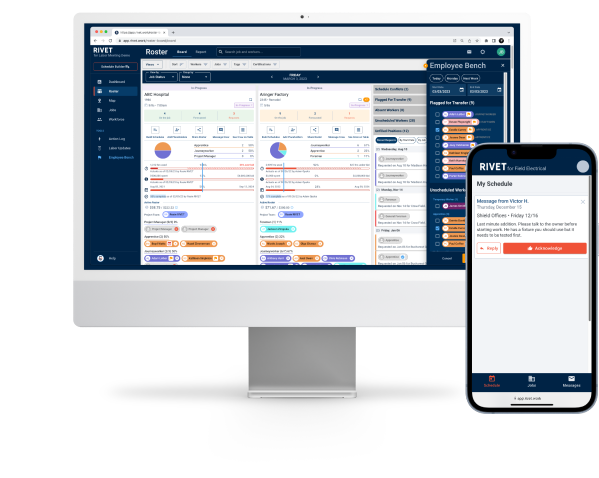
17. Competitive Advantage
Overview: Web apps can give construction contractors a competitive advantage by demonstrating an organization’s efficiency, culture of innovation and forward-thinking management practices.
Pain: Relying on spreadsheets may signal a lack of technological advancement, reducing competitive edge. Inefficiencies and errors associated with spreadsheet use can impact overall project quality and timeliness.
Solution: App software engineers work with experts like yourself to create solutions that are designed to solve specific problems efficiently. Don’t bring the entire hardware store (spreadsheets), when you can bring the perfect toolbox (apps).
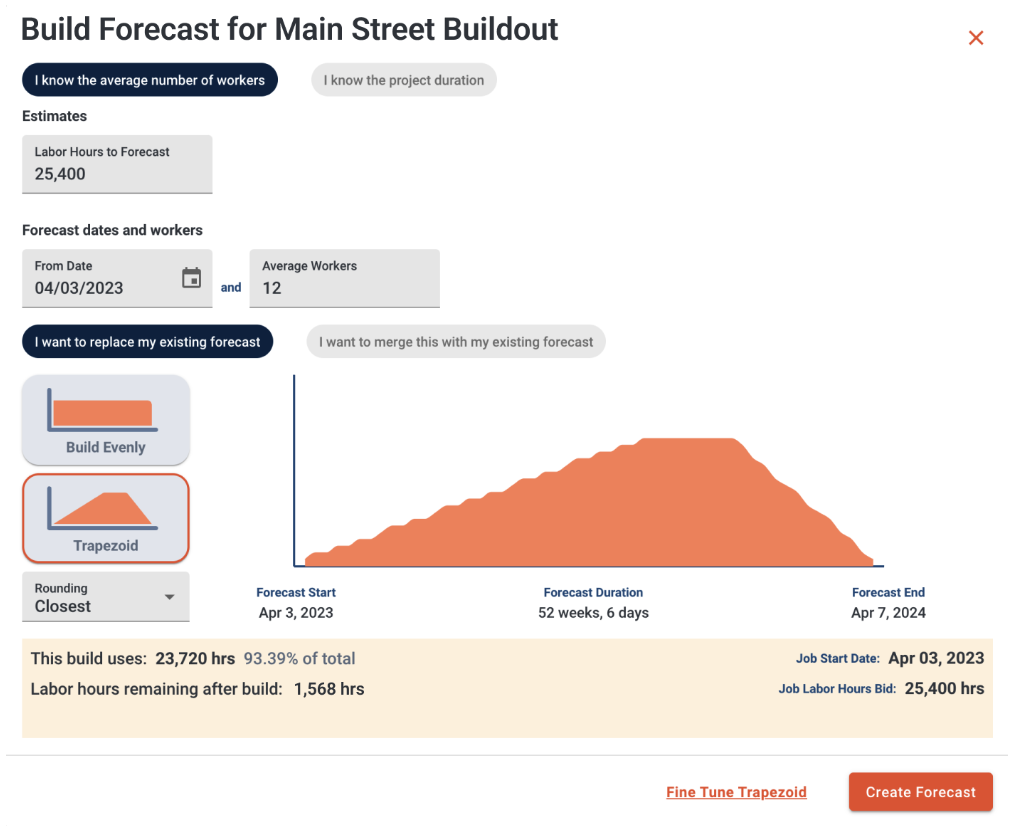
By transitioning to a dedicated application, project managers can mitigate these pain points, streamline workforce management, and enhance overall project efficiency and effectiveness.
To see how the RIVET Workforce Management platform can transform your self-performing contracting businesses, schedule a demo today.
